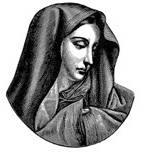
The Annunciation: Mary’s Magnificent Act of Consent
AN AUDACIOUS PROPOSAL, A COURAGEOUS RESPONSE
Ed. Note: The Feast of the Annunciation is March 25.
The walls of my 1920 craftsman home are covered — unsuitably, from a designer’s perspective, or anyone seeking compatibility of style and artifact — with a series of framed prints of the Annunciation. Most of these prints are copies of works originally created during the 14th-16th centuries in Western Europe by, among others, Duccio, Simone Martini, Fra Angelico, Leonardo da Vinci, and Botticelli. One of my favorites is an historical outlier, painted by 19th-century African-American artist Henry Ossawa Tanner, who, forsaking the gilded accents, rich brocades, and accoutrements of wealth preferred by many of his pious predecessors, used fabrics whose textures, and objects whose artlessness, clarify the poverty and ordinariness of Mary’s life. Within this space, an intense but rarified light illuminates the darkness of Mary’s abode, breaking through unexpectedly in the upper left-hand corner of the painting with an otherworldly luminosity, startling Mary awake with the sudden realization that she exists, inescapably, within the terrifying presence of the holy.
Why have I acquired a collection of Annunciation prints and hung them freely throughout my home? Although I confess a fondness for late Medieval and early Renaissance religious art, my reason is not primarily artistic. Instead, I love the meaning of the Annunciation itself and the significance it has come to have for me personally, beginning many years ago, as the perfect exemplar of consent. Why have I been fascinated with the concept of consent, the kind that, in my view, Mary exhibits so perfectly in practice? It is more difficult to answer this question, but I will try.
Nearly 50 years ago, as a young woman, I was struggling with how to live. I was in a graduate program and seemed to be, if not thriving, managing well enough. But I was floundering personally, holding fast to a relationship that I knew was not good for me but unable to extricate myself from it emotionally. As the years ticked by, my clarity regarding what I needed to do increased, as did my desire to do it, but I was stymied by persistent feelings of attachment. Meanwhile, I was floundering spiritually, too, unable to commit fully to any religious creed. I eventually realized that I was stymied not for intellectual reasons but due to a lack of will; ironically, this insight came to me in the course of my studies when I was directed to a volume of essays by Simone Weil entitled Waiting for God (1950). I write this now in the hope that her reflections might help others who are similarly stuck.
Weil’s idea of consent is developed in few words. Although I will refer to it as her concept of consent because it does have two required features, I doubt she would have thought of it this way, as her thoughts, while starkly provocative, are not fully developed. Despite her reticence, her words struck me as absolutely true, and they became both the occasion and the inspiration for my own exercise of consent in various aspects of my life. This, in turn, functioned as a kind of personal conversion experience.
I do not remember how the Annunciation acquired its personal significance for me as the representation par excellence of consent, but it did so, in keeping with its spiritual meaning for all of us. Accordingly, I began to collect artistic renderings of the Annunciation wherever I traveled, in various forms (artwork, postcards, icons, and prints), to serve as concrete, daily reminders of the importance of consent. When I dismantled my office post-retirement, I had so many that I could not find a new home for them all!
You May Also Enjoy
An intelligent group like feminist theologians could manufacture six or seven attractive religious ideas in any given morning, and then invent a sacrament or two over lunch.
Major apparitions of the Blessed Mother have occurred at those times when people most needed to hear her Gospel message.
The prophecy contains Heaven's plan to bring us the Peace of Jesus Christ, and warns of chastisement if the Church disobeys.

